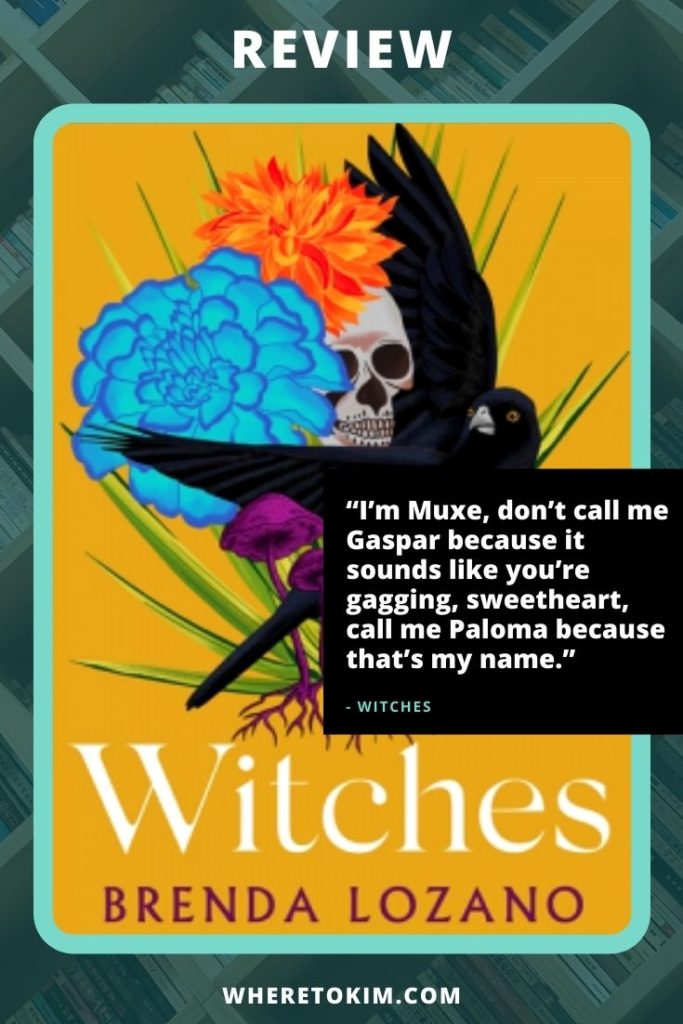In Witches, Brenda Lozano explores the role of gender and culture in Mexican society through a story about the lives, families, and strengths of a healer (curandera) and a journalist.
Location: Mexico City and San Felipe in Mexico
Synopsis Witches
This is the story of who Feliciana is, and of who Paloma was.
I had wanted to get to know them, but I realised right away that the people I needed to know better were my sister Leandra and my mother. Myself. I came to understand that you can’t really know another woman until you know yourself…
Weaving together two parallel narratives, Witches tells the story of Feliciana, an indigenous curandera or healer, and Zoe, a journalist: two women who meet through the murder of Feliciana’s cousin Paloma.
In the tiny village of San Felipe in Jalisco province, where traditional ways and traditional beliefs are a present reality, Feliciana tells the story of her life, her community’s acceptance of her as a genuine curandera and the difficult choices faced by her joyful and spirited cousin Paloma who is both a healer and a Muxe – a trans woman.
Growing up in Mexico City, Zoe attempts to find her way in a society straitjacketed by its hostile macho culture. But it is Feliciana’s and Paloma’s stories that draw her own story out of her, taking her on a journey to understanding her place in the world and the power of her voice.
This captivating novel of two Mexicos envisions the writer as a healer and offers a generous and distinctly female way of understanding the complex world we all inhabit.
Book review
Curanderas heal people’s present and future by treating what they have gone through in the past. It was not always accepted for women to perform these healing tasks as the curanderos (note the male ending) of old did. There are many rules and traditions to observe. Paloma – the one who was reportedly murdered – stopped being a curandera when she chose to spend time with men over performing healing ceremonies. Moreover, Paloma is a Muxe, a third gender recognized among the Zapotec peoples of Oaxaca that is used for people who are assigned male at birth but who dress and behave as women. The gender distinction and assumptions have been retained as much as possible in the translation.
Witch / Bruja / Curandera
The whole concept of what a curandera is and does is explained in sufficient detail so that you can easily understand the story. You read about the use of mushrooms and herbs for healing, about people coming from far away to seek out a curandera for healing, and how the curandera in question is not interested in things outside her world. She doesn’t speak Spanish or English, nor is she interested in luxury. She is confident in the way she lives her life.
Two writing styles
The writing style of Feliciana’s section takes some getting used to because it is written in a way that makes it seem as if she has been interviewed. Shorter sentences are combined into longer ones and there is no formatted dialogue. Thoughts and events are repeated many times. To a reader, it feels as if she is rambling. The story goes back and forth as the same events are told multiple times, each time adding a new detail to the story. Brenda Lozana takes her inspiration from the life of a healer who lived in the late 19th century. Zoe’s story is more conventional and easier to read. It doesn’t take long before you see similarities between the people in their lives.
This is not an easy book for me to review. On the one hand, I am interested in the lives of the people involved and the parallels that are drawn. On the other hand, the writing style used for Feliciana’s chapters never appeals to me in books. As a result, the first half of the book took me quite a while to get through. Once I had a clear picture of the setting, including family ties and timeline, I began to look more closely at the story and the comparison between the two narratives.
There’s power in the present
Feliciana’s strong sense of identity is evident in the way she tells her story. She seems to be a pillar of strength; this makes her account interesting. The strength she shows sticks with you. Her story continues and she matures. Zoe’s journey lingers more in the past: her dreams don’t evolve as much and her sister’s life seems to concern her more than her own. This is only natural because she is younger at the end of the book.
In the first half of the book, you feel like you are still in the part where the author sets the scene, but then you find out that this is the actual story. There is no linear progress between the past, present and future. After reading the synopsis, you can just forget about Paloma’s murder and concentrate on the strengths and weaknesses of the narrators. It is also worth noting the cultural contrasts and how gender is embedded in the culture. The contrasts between the characters, from their communication styles to the way they live their lives, are as prominent as the parallels that can be drawn between certain characters and events.
At the end you will find a note from the translator that I would have liked to read before the book itself. Quoting translator Heather Cleary: “Witches is an exploration of the many ways that women and gender non-comforming individuals are marginalised in our hetero-normative patriarchy.”
Interested?
Buy Witches from Amazon (available 14 April 2022).
Book details
Title: Witches
Author: Brenda Lozano
Translator (from Spanish): Heather Cleary
Language: English
Publisher: MacLehose Press
Pages: 272
ISBN (13): 9781529412277
Publication date: 14 April 2022
About the author and translator
Brenda Lozano is a fiction writer, essayist and editor. Born in Mexico City, she studied literature in Mexico and the United States. She has participated in literary residencies in the US, Europe and Latin America, and her work has appeared in several anthologies, including Mexico20 and Bogotá39. She edits the literary journal Make in Chicago and is part of Ugly Duckling Presse in New York. She is the author of two earlier novels, Todo nada (2009), which is currently being adapted for the screen, and Cuaderno Ideal (2015), recently published by Charco Press in an English translation by Annie McDermott as Loop, and a book of short stories, Cómo piensan las piedras (2017). In 2015, she was recognised by Conaculta, the Hay Festival and the British Council as one of the most important authors under forty years of age from Mexico, and in 2017 she was selected by the Hay Festival for Bogotá 39, a list of the most outstanding new authors from Latin America. She currently lives in Mexico City.
Heather Cleary is a translator and writer based in New York and Mexico City. Her essays and literary criticism have appeared in Two Lines, Lit Hub, and Words Without Borders, among other publications. Her book, The Translator’s Visibility: Scenes from Contemporary Latin American Fiction, which shows how narratives of translation can challenge norms of intellectual property and propriety, is out now from Bloomsbury. She holds an MA in Comparative Literature from NYU and a PhD in Latin American and Iberian Cultures from Columbia University, and teaches at Sarah Lawrence College.
Many thanks to MacLehose Press and NetGalley for a digital ARC of this novel in exchange for an honest review.







